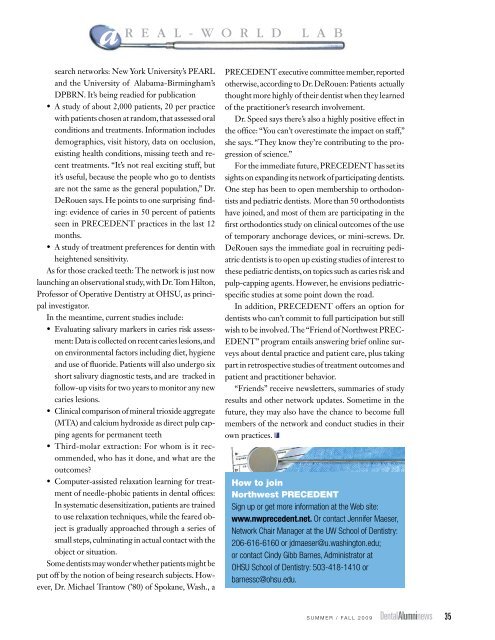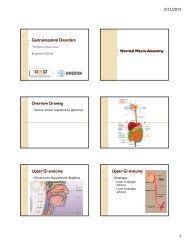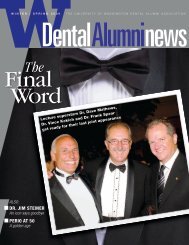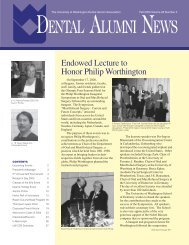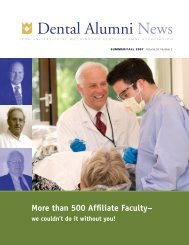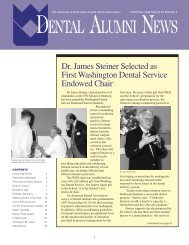dr - University of Washington School of Dentistry
dr - University of Washington School of Dentistry
dr - University of Washington School of Dentistry
You also want an ePaper? Increase the reach of your titles
YUMPU automatically turns print PDFs into web optimized ePapers that Google loves.
a<br />
R E A L - W O R L D L A B<br />
search networks: New York <strong>University</strong>’s PEARL<br />
and the <strong>University</strong> <strong>of</strong> Alabama-Birmingham’s<br />
DPBRN. It’s being readied for publication<br />
• A study <strong>of</strong> about 2,000 patients, 20 per practice<br />
with patients chosen at random, that assessed oral<br />
conditions and treatments. Information includes<br />
demographics, visit history, data on occlusion,<br />
existing health conditions, missing teeth and recent<br />
treatments. “It’s not real exciting stuff, but<br />
it’s useful, because the people who go to dentists<br />
are not the same as the general population,” Dr.<br />
DeRouen says. He points to one surprising finding:<br />
evidence <strong>of</strong> caries in 50 percent <strong>of</strong> patients<br />
seen in PRECEDENT practices in the last 12<br />
months.<br />
• A study <strong>of</strong> treatment preferences for dentin with<br />
heightened sensitivity.<br />
As for those cracked teeth: The network is just now<br />
launching an observational study, with Dr. Tom Hilton,<br />
Pr<strong>of</strong>essor <strong>of</strong> Operative <strong>Dentistry</strong> at OHSU, as principal<br />
investigator.<br />
In the meantime, current studies include:<br />
• Evaluating salivary markers in caries risk assessment:<br />
Data is collected on recent caries lesions, and<br />
on environmental factors including diet, hygiene<br />
and use <strong>of</strong> fluoride. Patients will also undergo six<br />
short salivary diagnostic tests, and are tracked in<br />
follow-up visits for two years to monitor any new<br />
caries lesions.<br />
• Clinical comparison <strong>of</strong> mineral trioxide aggregate<br />
(MTA) and calcium hy<strong>dr</strong>oxide as direct pulp capping<br />
agents for permanent teeth<br />
• Third-molar extraction: For whom is it recommended,<br />
who has it done, and what are the<br />
outcomes?<br />
• Computer-assisted relaxation learning for treatment<br />
<strong>of</strong> needle-phobic patients in dental <strong>of</strong>fices:<br />
In systematic desensitization, patients are trained<br />
to use relaxation techniques, while the feared object<br />
is gradually approached through a series <strong>of</strong><br />
small steps, culminating in actual contact with the<br />
object or situation.<br />
Some dentists may wonder whether patients might be<br />
put <strong>of</strong>f by the notion <strong>of</strong> being research subjects. However,<br />
Dr. Michael Trantow (’80) <strong>of</strong> Spokane, Wash., a<br />
PRECEDENT executive committee member, reported<br />
otherwise, according to Dr. DeRouen: Patients actually<br />
thought more highly <strong>of</strong> their dentist when they learned<br />
<strong>of</strong> the practitioner’s research involvement.<br />
Dr. Speed says there’s also a highly positive effect in<br />
the <strong>of</strong>fice: “You can’t overestimate the impact on staff,”<br />
she says. “They know they’re contributing to the progression<br />
<strong>of</strong> science.”<br />
For the immediate future, PRECEDENT has set its<br />
sights on expanding its network <strong>of</strong> participating dentists.<br />
One step has been to open membership to orthodontists<br />
and pediatric dentists. More than 50 orthodontists<br />
have joined, and most <strong>of</strong> them are participating in the<br />
first orthodontics study on clinical outcomes <strong>of</strong> the use<br />
<strong>of</strong> temporary anchorage devices, or mini-screws. Dr.<br />
DeRouen says the immediate goal in recruiting pediatric<br />
dentists is to open up existing studies <strong>of</strong> interest to<br />
these pediatric dentists, on topics such as caries risk and<br />
pulp-capping agents. However, he envisions pediatricspecific<br />
studies at some point down the road.<br />
In addition, PRECEDENT <strong>of</strong>fers an option for<br />
dentists who can’t commit to full participation but still<br />
wish to be involved. The “Friend <strong>of</strong> Northwest PREC-<br />
EDENT” program entails answering brief online surveys<br />
about dental practice and patient care, plus taking<br />
part in retrospective studies <strong>of</strong> treatment outcomes and<br />
patient and practitioner behavior.<br />
“Friends” receive newsletters, summaries <strong>of</strong> study<br />
results and other network updates. Sometime in the<br />
future, they may also have the chance to become full<br />
members <strong>of</strong> the network and conduct studies in their<br />
own practices.<br />
How to join<br />
Northwest PRECEDENT<br />
Sign up or get more information at the Web site:<br />
www.nwprecedent.net. Or contact Jennifer Maeser,<br />
Network Chair Manager at the UW <strong>School</strong> <strong>of</strong> <strong>Dentistry</strong>:<br />
206-616-6160 or jdmaeser@u.washington.edu;<br />
or contact Cindy Gibb Barnes, Administrator at<br />
OHSU <strong>School</strong> <strong>of</strong> <strong>Dentistry</strong>: 503-418-1410 or<br />
barnessc@ohsu.edu.<br />
SUMMER / FALL 2009 DentalAlumninews 35


